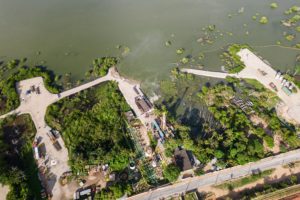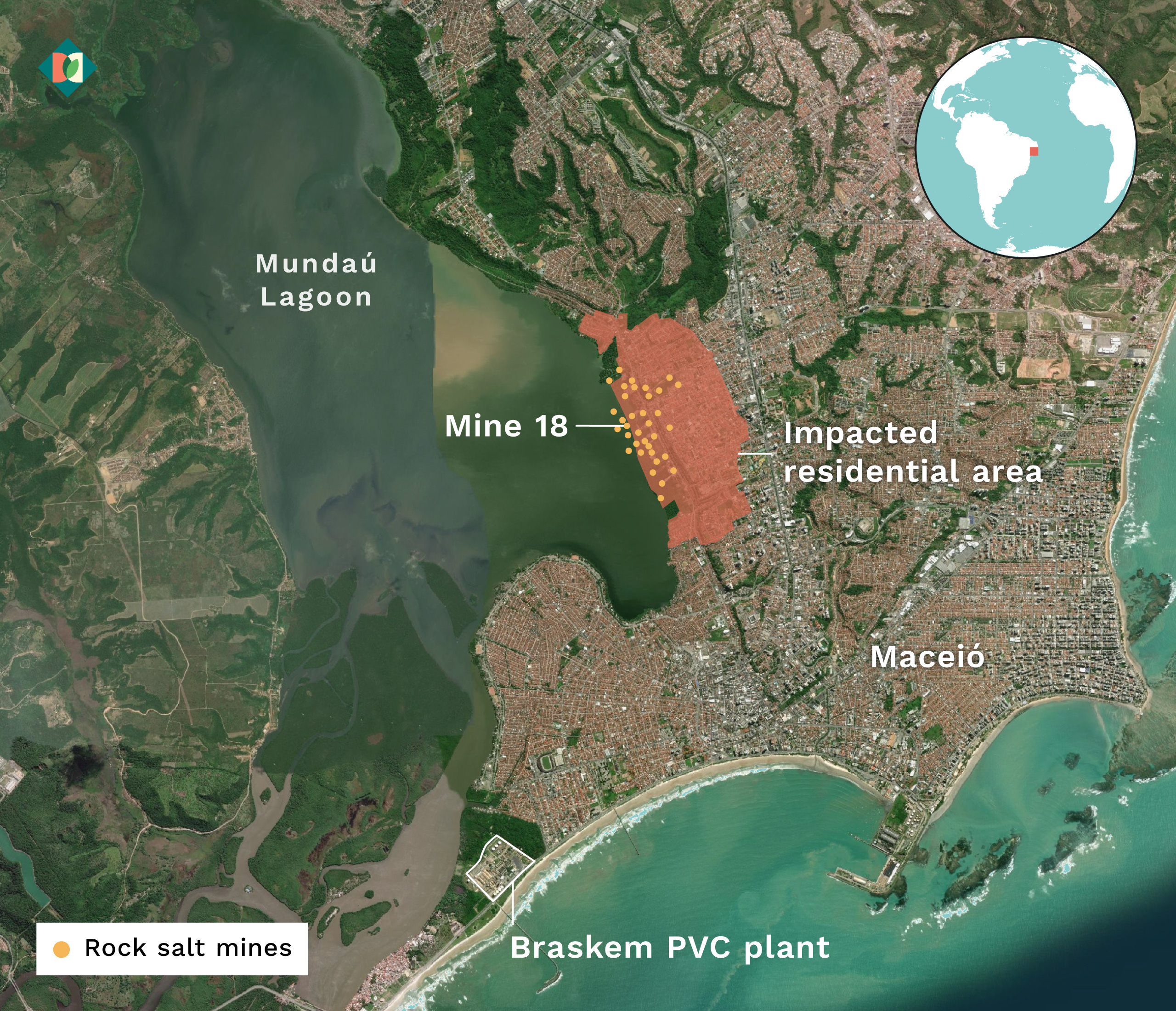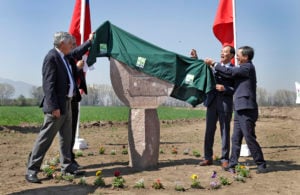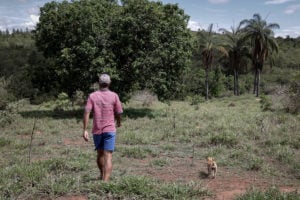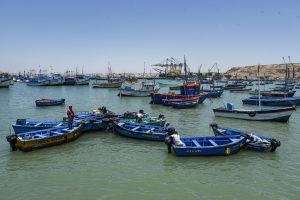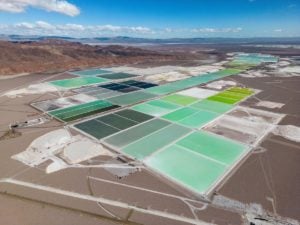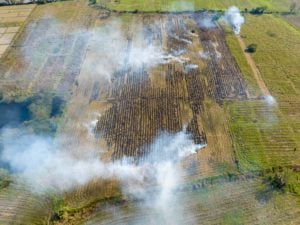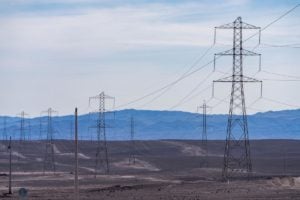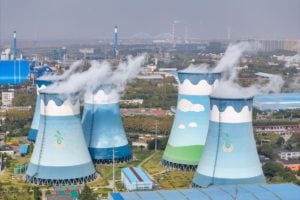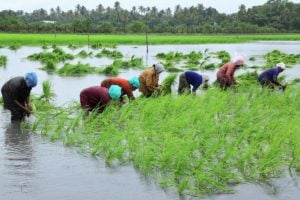In 1976, a shadow loomed over the paradise-like shores of Maceió, in Brazil’s north-eastern state of Alagoas: the arrival of a factory making polyvinyl chloride (PVC), the synthetic material used in a wide range of plastic products.
Opened by the petrochemical company Salgema, the factory’s location in the city’s Pontal da Barra neighbourhood – a spit of land that divides the vast Mundaú Lagoon from the Atlantic Ocean – was a strategic choice, with subsoils in the area home to an abundance of rock salt, an essential mineral in the production of PVC.
Almost five decades later, the site has become the scene of one of Brazil’s biggest mining accidents: a giant sinkhole, caused by the extraction of this rock salt, forming in nearby residential areas since 2018. The risk of collapse has led to the displacement of 60,000 people from five surrounding neighbourhoods. In December 2023, a salt mine on the shores of the lagoon, Mine 18, collapsed, bringing further impacts on its waters and the surrounding area.
Now, the case is once again in the spotlight following the first meeting of a parliamentary inquiry in the national congress, investigating the scale of the environmental damage in the area. Its commission will also be assessing possible failures and negligence by both the company and the state in the extraction of rock salt.
At the same time, victims are seeking justice for the environmental disaster and damages by taking the company and its international subsidiaries to court in the Netherlands.
The damage has not impacted just residents. Maceió’s sandbanks and mangroves, once forming an idyllic landscape, have also been transformed by the encroachment of this industry. “It was a true ecological paradise,” says retired professor and ecologist José Geraldo Wanderley Marques, one of the longest-serving and most staunch activists protesting against the factory and mining development.
In the mangroves, coastal birds such as herons, sandpipers and spoonbills found a habitat. Crabs and fish had also come to depend on this ecosystem for food and reproduction. With the arrival of the factory, the region became hostile to these animal species.
“What’s left of what was there before? Nothing,” Marques tells Diálogo Chino.
Company negligence
Salgema was formed in 1970 as a partnership between the National Development Bank (BNDES), US chemical giant Dupont, and Euvaldo Luz, an entrepreneur from Bahia state. Later that decade, Petroquisa, a subsidiary of state-owned oil company Petrobras, took over most of the shares.
During Brazil’s military dictatorship of 1964 to 1985 – marked by its free market propaganda over the supposed “economic miracle” – the presence of the factory was promoted as a boon to the local economy, recalls Marques. At the time, he worked in the environmental sector in Alagoas state.
The site has attracted interest not only for its mineral reserves of rock salt, but also for commercial reasons, due to the ease of exporting production from the nearby port of Maceió, as well as easy access to water for use in the factory’s industrial process.
According to Marques, the project ignored potential environmental risks, and was built before local authorities like himself could take action. Environmental licensing in Brazil was only required from 1981, with the introduction of the National Environmental Policy.
In 2002, after a merger of companies in the sector, the plant was incorporated into the newly created Braskem, a petrochemical company now controlled by Petrobras and the contractor Novonor – formerly known as Odebrecht until its rebrand in 2020, following its central role in one of the largest corruption scandals in Brazil and Latin America’s history.
Braskem itself was implicated in the Odebrecht investigations. According to a leniency agreement Braskem signed in November 2016 with the Federal Public Prosecutor’s Office, the company reportedly made use of a secret slush fund to pay bribes to politicians to gain contracts with Petrobras, though these were unrelated to the Maceió mine.
Visible damage from extraction activities
After a tremor in 2018, subsidence occurred in Maceió, damaging roads and buildings. The following year, Braskem stopped extracting rock salt in the area. In 2020, the company signed two agreements with the federal and state public prosecutors’ offices, committing to repair, mitigation and compensation for potential socio-environmental and urban damage from its activities.
As part of the agreements, the company engaged a consultancy to assess the impacts of its rock salt extraction in the area. The resulting document noted the loss of vegetation and the reduction in the animal population, the silting up of the Mundaú Lagoon, and the salinisation of aquifers.
Verônica Antunes is a professor at the Federal University of Alagoas, who monitors and researches the environmental impacts of rock salt mining in Maceió. She reports that 15 hectares of mangroves and sandbanks have been destroyed.
Antunes says that Braskem disregarded its impact on the built-up area and its surroundings, and that the reparation measures proposed by the company were not enough to ensure the region’s recovery: “However much the causal agent [Braskem] tries to repair it, the compensation will not be enough to re-establish the previous quality and conditions.”
In a statement to Diálogo Chino, Braskem said that 70% of the mine closure plan has been completed and that the work will be finalised by mid-2025. In a letter issued in 2023 outlining their commitments to the local community, the company also listed compensatory measures that have been adopted or are underway, such as the creation of a sustainable water use monitoring network and investments in mangrove planting projects to protect local species.
Nevertheless, complaints from the community persist. Local fishers and shellfish gatherers, for instance, lament the decline of stocks of the sururu mollusc in nearby waters. According to Natallya Levino, a professor at the Federal University of Alagoas, the sururu is crucial for the subsistence of the Mundaú Lagoon’s residents. It also plays the important role of helping to purify the water and, in the process, serves as an indicator of the health of the aquatic ecosystem, she notes.
The decline of the mollusc “could affect the whole community, since those who depend on sururu are financially vulnerable,” says Levino.
Neirevane Nunes is a biologist and member of the Unified Movement of Braskem Victims, a local activist group. For 40 years, she lived in Bebedouro, one of the Maceió neighbourhoods affected by cracks from the tremor and subsidence, until she was removed from the site in 2021. “We received derisory compensation from Braskem after three years of fighting with the public prosecutor’s office for a fair assessment,” she says.
As well as being a victim of the accident, the biologist also monitors the environmental health of the Mundaú Lagoon. Although conclusive data is lacking, she says the increase in salinity caused by the collapse of Mine 18 could lead to dehydration in sururu, jeopardising their survival.
“In addition to this physiological stress, for the sururu to be able to adapt to changes in salinity, it has to face other challenges such as pollution and historical contamination of the Mundaú Lagoon,” she adds.
The lagoon’s banks have also suffered from the impacts of urban occupation, some of which is illegal, as well as lack of sanitation, and other economic activities, such as sugar cane cultivation and the operation of meatpacking plants.
In addition, hydrochloric acid, a by-product of the PVC production process, and various other substances have been dumped into its waters over the years, according to José Geraldo Marques. However, he and other experts say there has been a lack of studies into the damage caused by this contamination.
In response to queries from Dialogo Chino, Braskem said that, since it was set up, the company has complied with all the licensing requirements. It did not respond to queries about waste dumping, including whether it had ever knowingly discharged substances into the water.
Fish or ‘die on an empty stomach’
From the age of three, Mauro Pedro dos Santos has helped his father fish. The 53-year-old is president of the Bebedouro Fishermen’s Colony, located on the shores of the Mundaú Lagoon – an area that is now unoccupied. Santos remembers with nostalgia the days where the region was replete with imposing mangroves. “There was a kind of mangrove, known as siriba, that reached a height of 30 metres,” he says.
At the time, a variety of crab and fish species, including moray eels, abounded in the area. “When it rained, the crabs would come out of the holes and we would catch them,” Santos adds. “Some we sold, others we ate.”
Although he recognises that various factors have contributed to the decline of species, the fisherman does not absolve Braskem of responsibility. Santos says that, in the last 15 years, the impacts have become more evident, with the mangroves shrinking and the soil giving way due to rock salt mining.
“It’s got to the point where the places we used to gather crabs and walk among the mangroves are now five to six metres deep. The mangroves have practically disappeared,” he notes.
While they await the compensation promised by the company – a single instalment of just three months’ worth of the minimum wage, amounting to R$4,236 (US$854) – in order to secure a catch many fishers are flouting the current ban on fishing and boating near the collapsed Mine 18.
“The bills were coming in, but the money wasn’t coming in, and the fishers would rather go fishing and make a living than die on an empty stomach,” says Santos. On 22 February, local authorities reduced the area closed to fishing in the lagoon, declaring that the risk of a new disaster had been controlled. But Santos is sceptical about the new directive, citing the fact that the impacts on the site have been ignored for decades.
He believes the rule meets Braskem’s strategy, which advocates for only one area to be closed, as a way of reducing compensation to fishers. According to Santos’s calculations, 1,800 fishers should be compensated for losing their source of livelihood. When asked for a figure, Braskem declined to comment on the matter.
“They’ve just reduced the affected area to give the impression that there’s no risk to fishers,” Santos notes. “If there are more sinkings and people die, it will be cheaper for the company to compensate the families of five or six people than to compensate all the fishers who have lost their source of livelihood.”
